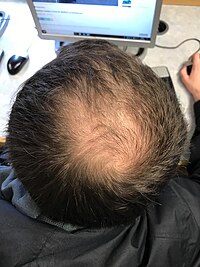
Photo from wikipedia
People commonly inquire about vitamin and mineral supplementation and diet as a means to prevent or manage dermatological diseases and, in particular, hair loss. Answering these queries is frequently challenging,… Click to show full abstract
People commonly inquire about vitamin and mineral supplementation and diet as a means to prevent or manage dermatological diseases and, in particular, hair loss. Answering these queries is frequently challenging, given the enormous and conflicting evidence that exists on this subject. There are several reasons to suspect a role for micronutrients in non-scarring alopecia. Micronutrients are major elements in the normal hair follicle cycle, playing a role in cellular turnover, a frequent occurrence in the matrix cells in the follicle bulb that are rapidly dividing. Management of alopecia is an essential aspect of clinical dermatology given the prevalence of hair loss and its significant impact on patients’ quality of life. The role of nutrition and diet in treating hair loss represents a dynamic and growing area of inquiry. In this review we summarize the role of vitamins and minerals, such as vitamin A, vitamin B, vitamin C, vitamin D, vitamin E, iron, selenium, and zinc, in non-scarring alopecia. A broad literature search of PubMed and Google Scholar was performed in July 2018 to compile published articles that study the relationship between vitamins and minerals, and hair loss. Micronutrients such as vitamins and minerals play an important, but not entirely clear role in normal hair follicle development and immune cell function. Deficiency of such micronutrients may represent a modifiable risk factor associated with the development, prevention, and treatment of alopecia. Given the role of vitamins and minerals in the hair cycle and immune defense mechanism, large double-blind placebo-controlled trials are required to determine the effect of specific micronutrient supplementation on hair growth in those with both micronutrient deficiency and non-scarring alopecia to establish any association between hair loss and such micronutrient deficiency.Plain Language Summary: Plain language summary available for this article.
Journal Title: Dermatology and Therapy
Year Published: 2018
Link to full text (if available)
Share on Social Media: Sign Up to like & get
recommendations!